气候对作物生产的影响较为明显,为了提高作物的适应性,前人从种植结构[1-2]、播期[3-5]、气候资源高效利用等方面做了非常多的研究[6-7]。河北平原主要为冬小麦-夏玉米一年两熟轮作种植,光热资源严重不足,积温紧张,年≥0 ℃积温4 400~5 050 ℃,玉米成熟度不够是生产上普遍存在的问题。根据热量条件确定夏玉米的适宜收获期以及冬小麦的适宜播期,研究玉米和小麦产量对积温的反应,从而确定适宜的播期和收获期,可以实现周年光热资源高效利用。
播期以及收获期是小麦玉米产量提高的关键因素[8-11]。其中播期是小麦取得高产的重要栽培措施之一[12]。小麦适宜播期的确定应以冬前积温和品种特性为依据[13-14],播期适宜可以构建良好的群体冠层结构, 利于穗数、穗粒数和千粒质量的协调发展[15],从而提高产量。推迟收获期是玉米获得高产的重要栽培措施之一,有研究表明,收获期每推迟1 d,产量可增加100~200 kg/hm2 [16-17]。因此,因地制宜地选择小麦的播期和玉米的收获期,是实现农业高产高效的重要途径。
近几年河北省大力推行冬小麦晚播、夏玉米晚收技术,但晚播及晚收期限的确定至今没有一致的定论。因此,本研究主要从小麦玉米周年轮作的角度,研究小麦对播期与冬前积温、玉米对收获期积温的响应特征,以期确定冬小麦晚播、夏玉米晚收的期限,为小麦、玉米两季合理分配光热资源提供理论和技术支撑。
1 材料和方法
1.1 试验地点
2012-2014年在河北省农林科学院粮油作物研究所堤上试验站进行田间试验。该区属太行山山前平原区(38°41′N, 116°85′E)。试验地0~20 cm土壤含有机质15.5 g/kg、全氮0.97 g/kg、全磷2.2 g/kg、碱解氮72.7 mg/kg、有效磷19.5 mg/kg和有效钾91.0 mg/kg。
1.2 试验品种
冬小麦选择2个半冬性品种,均为河北地区主栽品种, 包括冀麦585和金禾9123。夏玉米也选择河北地区主栽品种,2012年为郑单958和浚单20,2014年为郑单958和伟科702。
1.3 试验设计
冬小麦采用裂区试验设计, 播期为主区, 品种为副区, 小区采用完全随机排列,4次重复, 行距0.15 m, 小区面积14.16 m2。2012-2013年和2013-2014年均设4个播期处理,分别为10月5,10,15,20日, 播量分别为300,360,420,480万/hm2。底肥为史丹利复合肥(含N 20%、P2O5 26%、K2O 8%),于旋耕前施入600 kg/hm2,追肥为尿素(含N 46%),于拔节期灌水前施入,每公顷225 kg。小麦整个生育期灌水2次,拔节水和开花水, 总灌水量140 mm左右。6月7-10日收获。生育期间降水量和积温见表1。
表1 冬小麦试验设计及生育期气象条件
Tab.1 Experimental design and meteorological factors in whole period of winter wheat
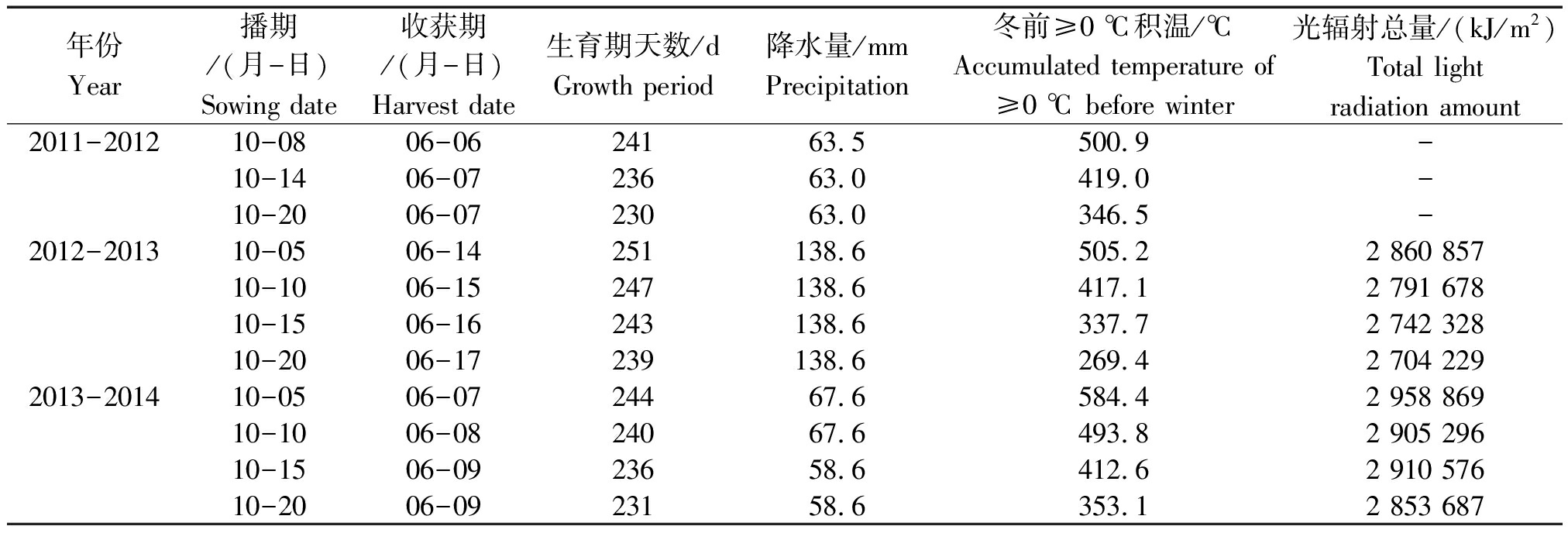
年份Year播期/(月-日)Sowing date收获期/(月-日)Harvest date生育期天数/dGrowth period降水量/mmPrecipitation冬前≥0 ℃积温/℃Accumulated temperature of≥0 ℃ before winter光辐射总量/(kJ/m2)Total light radiation amount2011-201210-0806-06241 63.5 500.9-10-1406-07236 63.0 419.0-10-2006-07230 63.0 346.5-2012-201310-0506-14251138.6 505.22 860 85710-1006-15247138.6 417.12 791 67810-1506-16243138.6 337.72 742 32810-2006-17239138.6 269.42 704 2292013-201410-0506-07244 67.6 584.42 958 86910-1006-08240 67.6 493.82 905 29610-1506-09236 58.6 412.62 910 57610-2006-09231 58.6 353.12 853 687
夏玉米为播期×收获期两因子试验,采用均匀试验设计。2012,2014年种植密度分别为 6.3,7.6万株/hm2,行距0.6 m,小区面积48 m2,4次重复。小区采用完全随机排列。底肥和追肥均选用沃夫特水溶肥(N 15%、P2O5 5%、K2O 25%),总施肥量900 kg/hm2。底肥与追肥按1∶1分配,底肥沟施,追肥于大喇叭口期喷施。为保证玉米出苗,播后立即灌水,灌水量70 mm左右,大喇叭口期喷肥同时灌第2水,灌水量15 mm左右,其他生育期未进行灌溉。具体玉米试验设计和生育期气候条件见表2。
表2 夏玉米试验设计及生育期气象条件
Tab.2 Experimental design and meteorological factors in whole period of summer maize
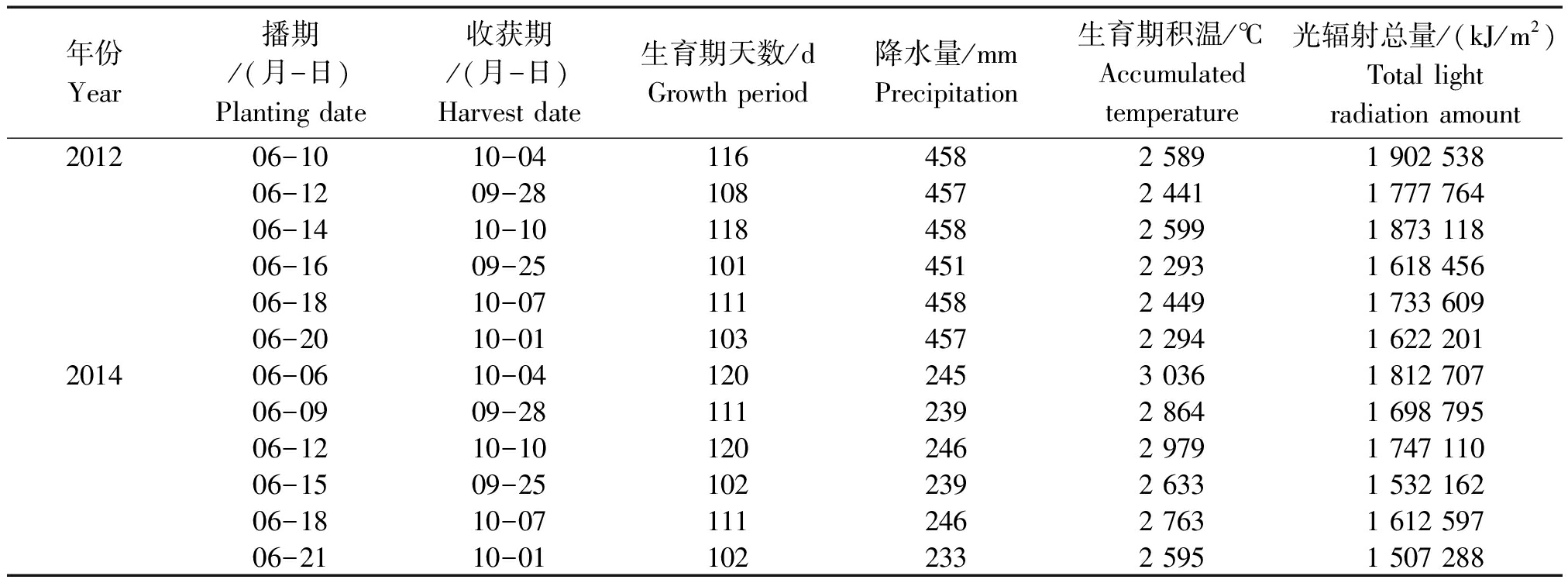
年份Year播期/(月-日)Planting date收获期/(月-日)Harvest date生育期天数/dGrowth period降水量/mmPrecipitation生育期积温/℃Accumulated temperature光辐射总量/(kJ/m2)Total light radiation amount201206-1010-041164582 5891 902 53806-1209-281084572 4411 777 76406-1410-101184582 5991 873 11806-1609-251014512 2931 618 45606-1810-071114582 4491 733 60906-2010-011034572 2941 622 201201406-0610-041202453 0361 812 70706-0909-281112392 8641 698 79506-1210-10 1202462 9791 747 11006-1509-251022392 6331 532 16206-1810-071112462 7631 612 59706-2110-011022332 5951 507 288
1.4 测定方法与数据处理
1993-2013年河北藁城市10-12月≥0 ℃积温数据(图1)和2007-2015年9-10月积温及平均气温数据(图2)均来自河北省气象局。
产量:冬小麦采用小区联合收割机收获小麦(CLASSIC, Wintersteiger, 4910 Ried in Innkreis, Austria),风干后称质量,同时采用谷物水分测定仪测定含水率,折算为含水量13%的标准产量。相对产量=品种某播期产量/品种播期平均产量。夏玉米每个小区收获3行玉米,每行收获10 m,称收获玉米果穗总鲜质量,然后按平均单穗鲜质量随机选取20穗,晾晒风干后脱粒,称质量,测定籽粒含水率,计算实际产量 (按14%折算含水率)[11]。
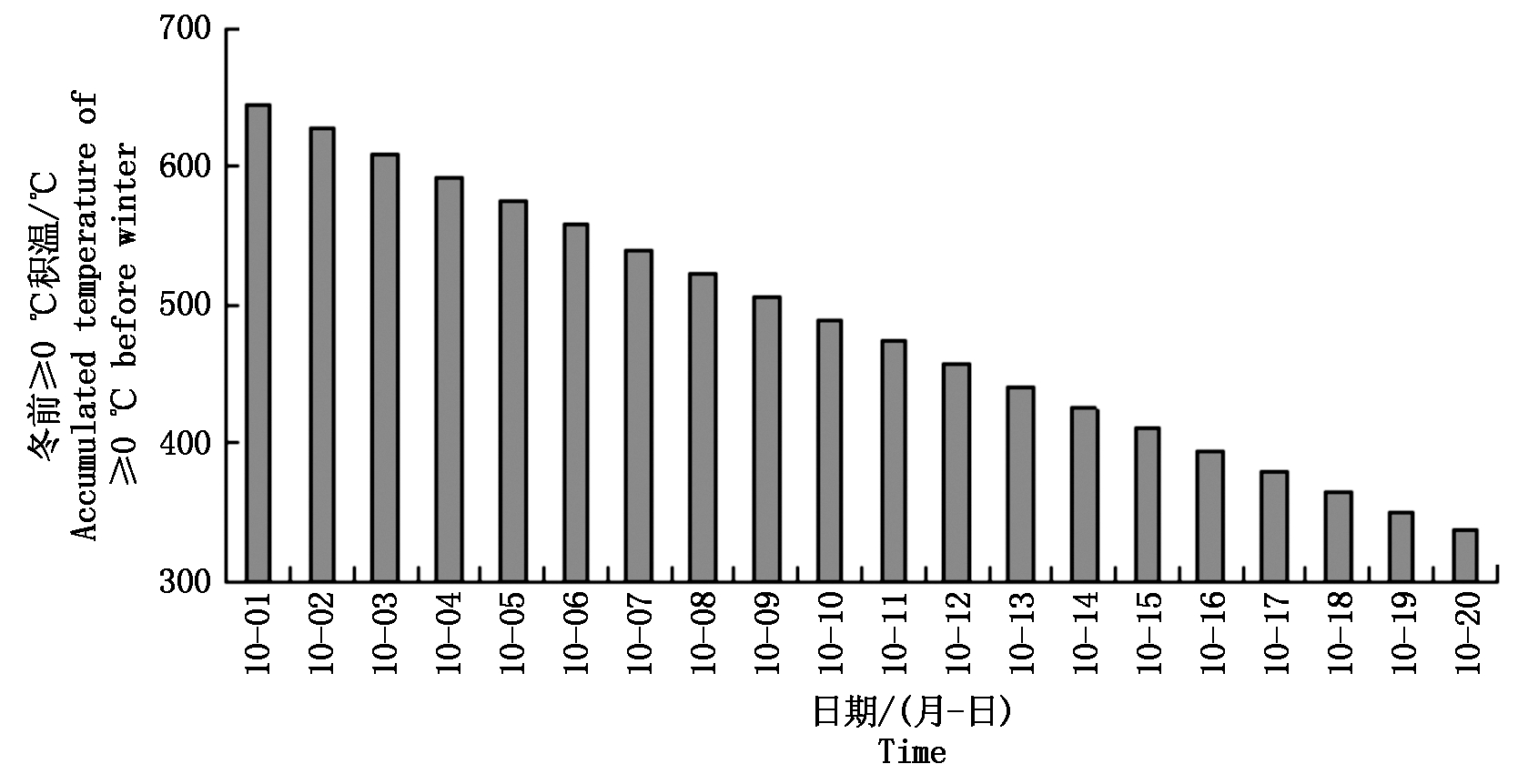
图1 1993-2013年藁城市由10月1日延至10月20日播种冬前≥0 ℃平均积温
Fig.1 Average ≥0 ℃ accumulated temperature before winter under sowing time
from October 1st to 20th of Gaocheng in 1993-2013
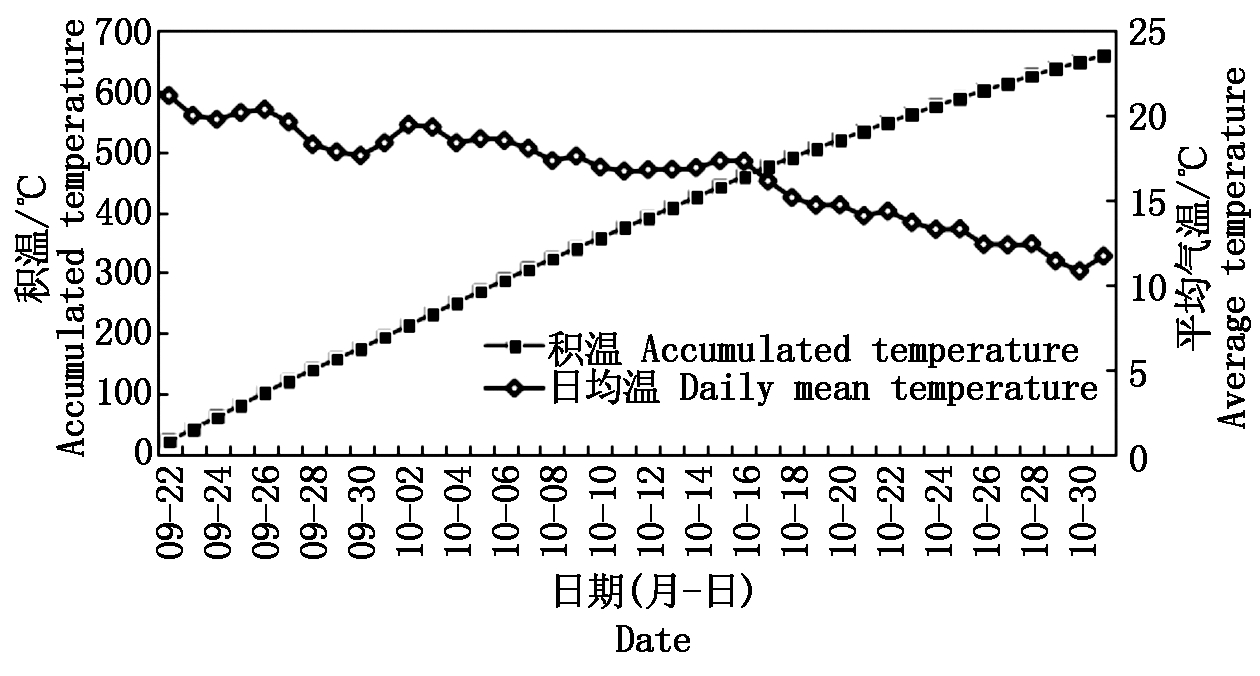
图2 2007-2015年玉米灌浆后期藁城气温和积温
Fig.2 The temperature and accumulated temperature of
late stage of filling for Gaocheng from 2007 to 2015
光能利用率: RUE=(H×W/ΣQ)×100%(H-单位质量有机干物质的产热率,W-单位土地面积上作物有机干物质的质量,籽粒取16.3×103 kJ/kg,ΣQ-生育期内单位土地面积逐日太阳总辐射量累加值)[17]。
1.5 数据分析
采用Microsoft Excel 2007处理数据和作图、SAS 6.12统计软件进行回归及方差分析,处理间显著性差异采用 LSD 法进行检验(α=0.05) 。
2 结果与分析
2.1 冬小麦晚播期限的确定
金禾9123和冀麦585分别属于迟钝型和中间型小麦品种[18]。经过对3 a的数据进行模拟分析, 得出迟钝型品种金禾9123和中间型品种冀麦585冬前≥0 ℃积温分别下降到425,450 ℃可获得最高产量。当相对产量(y)=1时, 可得到不同类型品种的冬前≥0 ℃积温上限和下限(图3), 再结合冬前积温(图1),可推算出小麦品种的适宜播期。金禾9123冬前积温下限和上限分别为324,560 ℃,冀麦585分别为362,566 ℃;根据图2可知金禾9123积温范围对应的日期为10月7-22日,冀麦585对应的日期为10月7-19日。可见,冀麦585和金禾9123播期可推迟至10月20日左右,且晚播后产量不会受到明显影响。因此可得出,在河北地区提倡小麦晚播技术切实可行,该结果为夏玉米晚收的实现提供了理论依据。
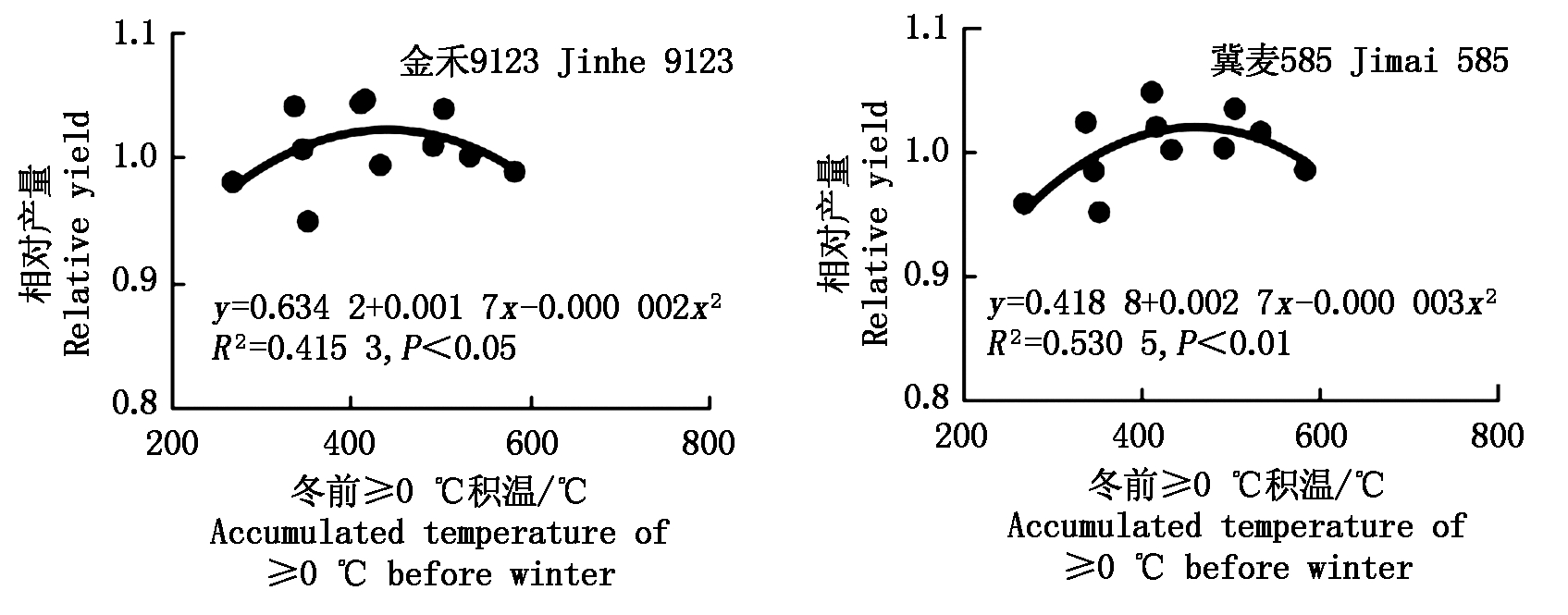
图3 2012-2014年小麦产量与冬前≥0 ℃积温的关系
Fig.3 Relationship between yield and ≥0 ℃ accumulated temperature before winter of wheat cultivars in 2012-2014
2.2 夏玉米晚收期限的确定
2.2.1 播期、收获期对夏玉米光能利用率(RUE)的影响 2012年,成熟期籽粒 RUE 表现为收获较早(6月16日播种+9月25日收获)和播种较晚(6月20日播种)的2个处理较低,尤其播种较晚的处理RUE明显较低(表3)。2014年趋势大体一致,除晚播的郑单958之外,也表现为收获较早(6月15日播种+9月25日收获)和播种较晚(6月21日播种)的2个处理RUE较低,尤其收获较早的处理RUE明显较低。说明适时早播和延迟收获时间相结合,是提高玉米光能利用率的重要途径。
2 a结果表明,郑单958光能转化效率较高,其 RUE 明显高于浚单20和伟科702,2012年高 6.3%~10.4%,平均高8.0%,2014年高1.0%~14.6%,平均高5.6%。
表3 播期和收获期对玉米籽粒光能利用率的影响
Tab.3 Radiation utilization efficiency (RUE) of summer maize under different sowing and harvest date

播期(月-日)Sowing date2012年光能利用率/% RUE 郑单958Zhengdan 958浚单20Xundan 20播期(月-日)Sowing date2014年光能利用率/% RUE 郑单958Zhengdan 958伟科702Weike 70206-100.85±0.03a0.79±0.02a06-060.99±0.06a0.91±0.05a06-120.85±0.04a0.77±0.02a06-090.96±0.05a0.95±0.06a06-140.86±0.04a0.79±0.03a06-120.95±0.05a0.93±0.07a06-16 0.82±0.03ab0.77±0.01a06-15 0.89±0.02ab 0.84±0.05ab06-180.84±0.02a0.79±0.03a06-181.01±0.06a1.00±0.08a06-20 0.80±0.03ab0.74±0.01b06-211.02±0.09a 0.89±0.03ab
注:同列数据后小写英文字母不同,表示在0.05水平上存在差异。表4同。
Note: The different letters after the same column mean difference significant among different treatments at the 0.05 level. The same as Tab.4.
2.2.2 播期、收获期对夏玉米产量的影响 采用逐步回归统计方法得出,产量(y)与收获期(x1)和播期(x2)呈线性关系,二者对玉米产量影响均达极显著水平(表4)。但2 a试验结果稍有差异,2012年可用公式y=4 259 709.70+97.50x1-196.51x2(R=0.996 5,P<0.01)进行拟合,说明玉米每早播1 d和迟收1 d,产量分别增加196.5,97.5 kg/hm2;而2014年可用公式y=-210 200.13+103.31x1-98.44x2(R=0.902 0,P<0.01)拟合,说明玉米每早播1 d和迟收1 d产量分别增加98.4,103.3 kg/hm2。而不同年份播期和收获期增产幅度不同,但2 a推迟收获期的增产幅度相当,玉米晚收获1 d产量可平均增加100.4 kg/hm2。
表4 不同播期和收获期玉米产量变化趋势
Tab.4 Chang trend of maize yield at different sowing and harvest dates

播期(月-日)Sowing date2012年产量/(kg/hm2) Grain yield郑单958Zhengdan 958浚单20Xundan 20播期(月-日)Sowing date2014年产量/(kg/hm2) Grain yield郑单958Zhengdan 958伟科702Weike 70206-1011 581.5±510.1a10 788±604.4a06-0610 985.9±629.8a10 131.0±359.4a06-1210 843.5±367.9a9 814.5±412.3ab06-0910 042.9±284.6ab9 891.1±482.3a06-1411 443.5±423.5a10 567.5±578.9a06-1210 177.8±347.5ab9 942.0±286.8a06-169 502.5±210.4bc8 872.5±597.3b06-158 393.2±476.3d7 899.1±114.6c06-1810 426.5±359.7ab9 721.5±445.6ab06-189 987.9±246.9ab9 850.0±543.9a06-209 204.0±321.4c8 574.0±278.8bc06-219 477.7±357.1c8 203.5±287.4b
2.2.3 夏玉米适宜收获期的确定 以9月25日为基点,计算了每推迟3 d玉米总的增产量,根据积温变化量与增产量计算出100 ℃积温增产量(表5),由表5可见,2 a 100 ℃积温增产量十分接近。因此,把2 a数据平均后,得到延迟玉米收获期后积温变化量与玉米增产量拟合方程y=0.225 3x+527.72 (R2=0.880 4,P<0.01),拟合方程达极显著水平(图4)。表明,在玉米收获期,100 ℃积温可增产527.7 kg/hm2。
根据2016年12月对藁城市7村140户调查数据表明,当地农户平均玉米收获时间9月22日,近4 a平均产量7 770 kg/hm2。假如收获期由9月22日推迟至10月10日,根据图2玉米积温可增加358 ℃,可实现玉米增产1 889.2 kg/hm2,增产率24.3%。
前人研究表明,玉米灌浆有效日均温为16 ℃[17-18],根据图2石家庄该日期为10月17日,说明玉米最晚收获期可推迟至17日。9月22日-10月17日积温可增加476 ℃,玉米增产潜力可达2 511.9 kg/hm2。
表5 晚收条件下玉米增产潜力分析
Tab.5 Analysis of yield increasing potential of maize under late harvest condition
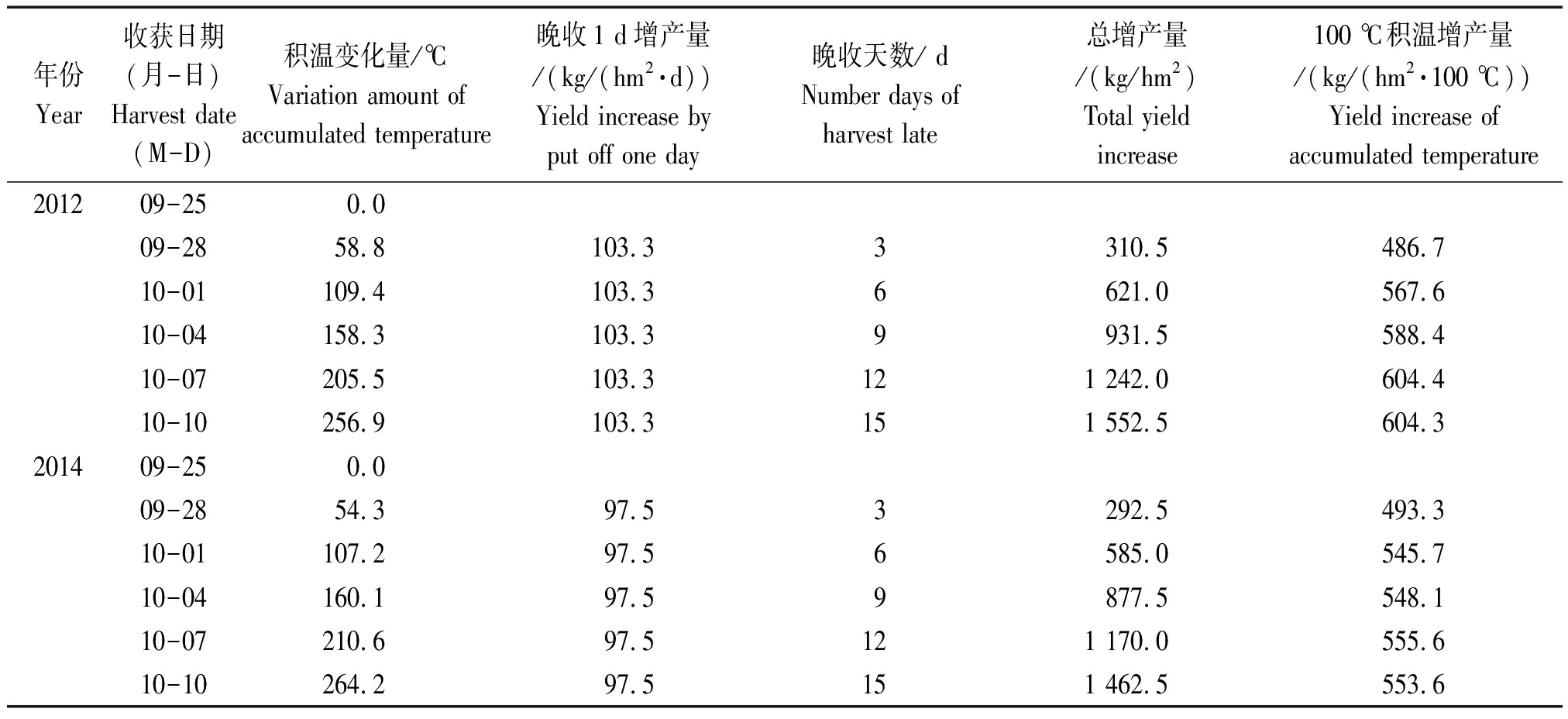
年份Year收获日期(月-日)Harvest date(M-D)积温变化量/℃Variation amount ofaccumulated temperature 晚收1 d增产量/(kg/(hm2·d))Yield increase byput off one day晚收天数/ dNumber days ofharvest late总增产量/(kg/hm2)Total yieldincrease100 ℃积温增产量/(kg/(hm2·100 ℃))Yield increase of accumulated temperature 201209-25 0.009-2858.8103.33310.5486.710-01109.4103.36621.0567.610-04158.3103.39931.5588.410-07205.5103.3121 242.0604.410-10256.9103.3151 552.5604.3201409-25 0.009-28 54.397.53292.5493.310-01107.297.56585.0545.710-04160.197.59877.5548.110-07210.697.5121 170.0555.610-10264.297.5151 462.5553.6

图4 玉米延迟收获条件下积温变化量与玉米增产量关系
Fig.4 Relationship between accumulated temperature and
maize yield increase during delayed maize harvest
3 讨论与结论
关于冬小麦适宜播期的选择,作者在其他论文中已详细论述[18-19],认为迟钝型品种金禾9123和中间型品种冀麦585冬前≥0 ℃积温分别≥324 ℃和≥362 ℃即可取得高产,该积温较传统的高产田冬前壮苗积温(≥570 ℃)低许多。根据藁城多年积温数据,该积温下限对应的日期为10月20日左右。该结果为冬小麦晚播期限的确定提供了理论依据。
前人研究表明,玉米灌浆期≥10 ℃积温的增加有利于产量构成因素增加[20-21],积温越高产量越高,说明作物生长需要一定的热量积累。灌浆期是玉米一生最终决定产量的重要时期。玉米籽粒重量决定于灌浆期的有效灌浆时间和灌浆强度,二者直接受灌浆期的积温、平均气温和日照时数的影响[22]。前人研究表明,当日均温达16 ℃以下时,玉米灌浆速度明显下降,达14 ℃以下时,灌浆几乎停止[21]。石家庄16 ℃平均气温对应的日期为10月17日,说明玉米最晚收获期可推迟至17日。假如玉米收获期由农民传统的9月22日推迟至10月17日,≥16 ℃积温可增加476 ℃,玉米增产潜力可达2 511.9 kg/hm2。该结果为夏玉米晚播期限的确定提供了理论依据。
[1] 李克南,杨晓光,慕臣英,徐华军,陈阜. 全球气候变暖对中国种植制度可能影响Ⅷ-气候变化对中国冬小麦春性品种种植界限的影响[J]. 中国农业科学, 2013, 46(8): 1583-1594. doi: 10.3864/j.issn.0578-1752.2013.08.007.
Li K N, Yang X G, Mu C Y, Xu H J, Chen F. The possible effects of global warming on cropping systems in China Ⅷ-The effects of climate change on planting boundaries of different winte-spring varieties of winter wheat in China[J]. Scientia Agricultura Sinica, 2013, 46(8): 1583-1594.
[2] Liu Z H, Yang P, Wu W B, You L Z. Spatiotemporal changes of cropping structure in China during 1980-2011[J]. Journal of Geographical Sciences, 2018, 28(11): 1659-1671. doi:10.1007/s11442-018-1535-4.
[3] 刘小丽,王凯,杨珍平,薛建福,杜天庆,宗毓铮,郝兴宇,孙敏,高志强. 播期与播种方式的不同配套对一年两作区旱地冬小麦农艺性状及产量的影响[J]. 华北农学报, 2018, 33(2): 232-238. doi: 10.7668/hbnxb.2018.02.032.
Liu X L, Wang K, Yang Z P, Xue J F, Du T Q, Zong L Z, Hao X Y, Sun M, Gao Z Q. Effect of different sowing dates and sowing methods on agronomic characters and yield of dry land winter wheat in two-cropping areas[J]. Acta Agriculturae Boreali-Sinica, 2018, 33(2): 232-238.
[4] 高培芳,金永贵,孙敏,梁艳妃. 休闲期深松及播期对旱地小麦干物质累积特性与产量的影响[J]. 华北农学报, 2018, 33 (4): 160-166. doi: 10.7668/hbnxb.2018.04.023.
Gao P F, Jin Y G, Sun M, Liang Y F. Effects of subsoiling during fallow period and sowing date on dry matter accumulation and yield of wheat in dryland[J]. Acta Agriculturae Boreali-Sinica, 2018, 33 (4): 160-166.
[5] 吕丽华,梁双波,张丽华,贾秀领,张晓. 播期、收获期对玉米生长发育及冠层性状的调控[J]. 玉米科学, 2015, 23(6): 76-83. doi: 10.13597/j.cnki.maize.science.20150614.
Lü L H, Liang S B, Zhang L H, Jia X L, Zhang X. Effects of planting and harvest date on growth and development and canopy traits of summer maize[J]. Journal of Maize Sciences, 2015, 23(6): 76-83.
[6] 王培娟,韩丽娟,周广胜,梁宏. 气候变暖对东北三省春玉米布局的可能影响及其应对策略[J]. 自然资源学报, 2015, 30(8): 1343-1355. doi: 10.11849/zrzyxb.2015.08.009.
Wang P J, Han L J, Zhou G S, Liang H. The effects of climate warming on different cultivars of spring maize under climate warming in Northeast China and the adaptation countermeasures[J]. Journal of Natural Resources, 2015, 30(8): 1343-1355.
[7] 张丽敏,张淑杰,郭海,王萍,王冬妮,李杰. 东北春玉米适宜生长期农业气候资源变化及其影响分析[J]. 江西农业学报, 2018,30(2): 93-99. doi: 10.19386/j.cnki.jxnyxb.2018.02.20.
Zhang L M, Zhang S J, Guo H, Wang P, Wang D N, Li J. Variations and effects of agricultural climatic resources in suitable growth period of spring maize in Northeast China[J]. Acta Agriculturae Jiangxi, 2018,30(2): 93-99.
[8] 简大为, 祁军, 张燕, 苏甫热木, 张喜琴. 播种期和密度对冬小麦新冬29号产量形成的影响[J]. 西北农业学报, 2011, 20(11): 47-51.
Jian D W, Qi J, Zhang Y, Su P R M, Zhang X Q. Effect of sowing date and planting density on the yield formation of a winter wheat cultivar Xindong 29[J]. Acta Agric Boreali-Occid Sin, 2011, 20(11): 47-51.
[9] 杨宗渠,尹飞,王翔,李永春,任江萍, 尹钧. 冬前积温对小麦光能利用率的调控效应[J]. 核农学报, 2014, 28(8): 1489-1496.
Yang Z Q, Yin F, Wang X, Li Y C, Ren J P, Yin J. Regulating effect of accumulated temperature prior to wintering of light use efficiency in winter wheat (Triticum aestivum L.) [J]. Journal of Nuclear Agricultural Sciences, 2014, 28(8):1489-1496.
[10] Kamara A Y, Ekeleme F, Chikoye D, Omoigui L O. Planting data and cultivar effects on grain yield in dryland corn production[J]. Agronomy Journal, 2009(101): 91-98. doi:10.2134/agronj2008.0090.
[11] 吕丽华, 董志强, 曹洁璇, 梁双波, 贾秀领, 张丽华, 姚艳荣. 播期、收获期对玉米物质生产及光能利用的调控效应[J]. 华北农学报, 2013, 28(S1): 177-183. doi: 10.7668/hbnxb.2013.S1.033.
Lv L H, Dong Z Q, Cao J X, Liang S B, Jia X L, Zhang L H, Yao Y R. Effects of planting and harvest date on matter production of summer maize and its utilization of solar and heat resource[J]. Acta Agriculturae Boreali-Sinica, 2013, 28(S1): 177-183.
[12] 陈素英, 张喜英, 毛任钊, 王彦梅, 孙宏勇. 播期和播量对冬小麦冠层光合有效辐射和产量的影响[J]. 中国生态农业学报, 2009, 17(4): 681-685. doi: 10.3724/SP.J.1011.2009.00681.
Chen S Y, Zhang X Y, Mao R Z, Wang Y M, Sun H Y. Effect of sowing date and rate on canopy intercepted photo-synthetically active radiation and yield of winter wheat[J]. Chinese Journal of Eco-Agriculture, 2009, 17(4): 681-685.
[13] Chen C C, Payne W A, Smiley R, Stoltz M A. Yield and water-use efficiency of eight wheat cultivars planted on seven dates in northeastern oregon[J]. Agronomy Journal. 2003, 95: 836-843. doi: 10.2134/agronj2003.0836.
[14] Nleya T, Rickertsen J R. Winter wheat response to planting date under dryland conditions[J]. Agronomy Journal, 2014, 106(3): 915-924. doi: 10.2134/agronj13.0417.
[15] 张维诚,王志和,任永信,朱明哲. 有效分蘖终止期控制措施对小麦群体质量影响的研究[J]. 作物学报, 1998, 24(6): 903-906.
Zhang W C, Wang Z H, Ren Y X, Zhu M Z. Influences of control measures for end of valid tillering on population quality of winter wheat[J]. Acta Agronomica Sinica, 1998, 24(6): 903-906.
[16] 路海东,薛吉全,马国胜,,张仁和,张兴华,李凤艳,郝引川. 收获期对不同栽培措施玉米产量及粒重的影响[J]. 玉米科学, 2011, 19(1): 101-104.
Lu H D, Xue J Q, Ma G S, Zhang R H, Zhang X H, Li F Y, Hao Y C. Effects of delaying harvester and different cultivation measures on yield and grain weight of maize[J]. Journal of Maize Sciences, 2011, 19(1): 101-104.
[17] 王立祥, 李军. 农作学[M]. 北京: 科学出版社, 2003, 9: 179.
Wang L X, Li J. Agronomy[M]. Beijing: Science Press, 2003, 9: 179.
[18] 吕丽华,梁双波,张丽华,贾秀领,董志强,姚艳荣. 不同小麦品种产量对冬前积温变化的响应[J]. 作物学报, 2016, 42(1): 149-156. doi: 10.3724/SP.J.1006.2016.00149.
Lv L H, Liang S B, Zhang L H, Jia X L, Dong Z Q, Yao Y R. Yield in response to accumulated temperature before winter in winter wheat[J]. Acta Agronomica Sinica, 2016, 42(1): 149-156.
[19] 吕丽华,梁双波,姚海坡,张丽华,马贞玉,贾秀领. 播期对冬小麦成穗能力的影响[J]. 河北农业科学, 2016, 20 (3): 1-5, 9. doi:10.16318/j.cnki.hbnykx.2016.03.001.
Lü L H, Liang S B, Yao H P, Zhang L H, Ma Z Y, Jia X L. Effect of sowing date on spike form for wheat cultivars[J]. Journal of Hebei Agricultural Sciences, 2016, 20 (3): 1-5, 9.
[20] 王晓群,杨彦龙,张宇,周平. 不同生育阶段气象因子对玉米产量及构成要素的影响分析[J]. 中国农学通报, 2015, 31(30): 68-73.
Wang X Q, Yang Y L, Zhang Y, Zhou P. Analysis of the effects of meteorological factors at different growth stages on yield and yield components of maize(Zea mays L.) [J]. Chinese Agricultural science Bulletin, 2015, 31(30): 68-73.
[21] 陈传晓,董志强,高娇,徐田军,焦浏,卢霖,张凤路. 不同积温对春玉米灌浆期叶片光合性能的影响[J]. 应用生态学报, 2013, 24(6): 1593-1600.
Chen C X, Dong Z Q, Gao J, Xu T J, Jiao L, Lu L, Zhang F L. Effects of different accumulated temperature on photosynthetic performances of spring maize varieties during grain-filling period[J]. Chinese Journal of Applied Ecology, 2013, 24(6): 1593-1600.
[22] 余肇福,高妙贞,杨志伟.玉米冷害的关键期及生育不良型冷害[J]. 东北农业大学学报, 1985, 16(3): 46-52. doi: 10.19720/j.cnki.issn.1005-9369.1985.03.009.
Yu Z F, Gao M Z, Yang Z W. The critical stage and poor-development type of chilling injury in corn[J]. Journal of Northeast Agricultural University, 1985, 16(3): 46-52.